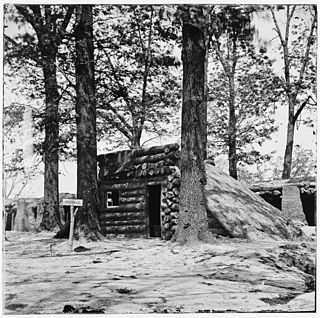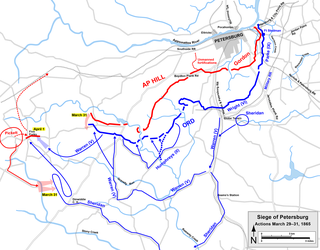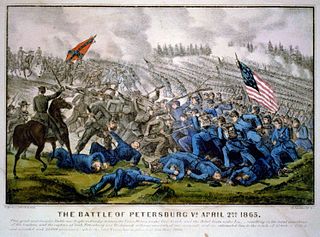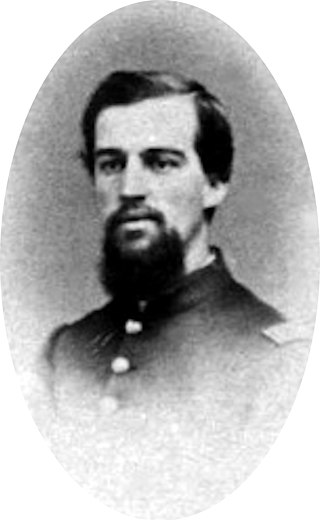
The Richmond–Petersburg campaign was a series of battles around Petersburg, Virginia, fought from June 9, 1864, to March 25, 1865, during the American Civil War. Although it is more popularly known as the siege of Petersburg, it was not a classic military siege, in which a city is encircled with fortifications blocking all routes of ingress and egress, nor was it strictly limited to actions against Petersburg. The campaign consisted of nine months of trench warfare in which Union forces commanded by Lieutenant General Ulysses S. Grant assaulted Petersburg unsuccessfully and then constructed trench lines that eventually extended over 30 miles (48 km) from the eastern outskirts of Richmond, Virginia, to around the eastern and southern outskirts of Petersburg. Petersburg was crucial to the supply of Confederate General Robert E. Lee's army and the Confederate capital of Richmond. Numerous raids were conducted and battles fought in attempts to cut off the Richmond and Petersburg Railroad. Many of these battles caused the lengthening of the trench lines.

The Battle of Five Forks was fought on April 1, 1865, southwest of Petersburg, Virginia, around the road junction of Five Forks, Dinwiddie County, at the end of the Siege of Petersburg, near the conclusion of the American Civil War.

The Battle of Fort Stedman, also known as the Battle of Hare's Hill, was fought on March 25, 1865, during the final weeks of the American Civil War. The Union Army fortification in the siege lines around Petersburg, Virginia, was attacked in a pre-dawn Confederate assault by troops led by Maj. Gen. John B. Gordon. The attack was the last serious attempt by Confederate troops to break the Siege of Petersburg. After an initial success, Gordon's men were driven back by Union troops of the IX Corps commanded by Maj. Gen. John G. Parke.

The Battle of Dinwiddie Court House was fought on March 31, 1865, during the American Civil War at the end of the Richmond-Petersburg Campaign and in the beginning stage of the Appomattox Campaign. Along with the Battle of White Oak Road which was fought simultaneously on March 31, the battle involved the last offensive action by General Robert E. Lee's Confederate Army of Northern Virginia attempting to stop the progress of Lieutenant General Ulysses S. Grant's Union Army. Grant's forces were moving to cut the remaining Confederate supply lines and to force the Confederates to extend their defensive lines at Petersburg, Virginia and Richmond, Virginia to the breaking point, if not to force them into a decisive open field battle.
The Battle of Lewis's Farm was fought on March 29, 1865, in Dinwiddie County, Virginia near the end of the American Civil War. In climactic battles at the end of the Richmond–Petersburg Campaign, usually referred to as the Siege of Petersburg, starting with Lewis's Farm, the Union Army commanded by Lieutenant General Ulysses S. Grant dislodged the Confederate Army of Northern Virginia commanded by General Robert E. Lee from defensive lines at Petersburg, Virginia and the Confederate capital of Richmond, Virginia. Many historians and the United States National Park Service consider the Battle of Lewis's Farm to be the opening battle of the Appomattox Campaign, which resulted in the surrender of Lee's army on April 9, 1865.

The Third Battle of Petersburg, also known as the Breakthrough at Petersburg or the Fall of Petersburg, was fought on April 2, 1865, south and southwest Virginia in the area of Petersburg, Virginia, at the end of the 292-day Richmond–Petersburg Campaign and in the beginning stage of the Appomattox Campaign near the conclusion of the American Civil War. The Union Army under the overall command of General-in-Chief Lieutenant General Ulysses S. Grant, launched an assault on General Robert E. Lee's Confederate Army of Northern Virginia's Petersburg, Virginia, trenches and fortifications after the Union victory at the Battle of Five Forks on April 1, 1865. As a result of that battle the Confederate right flank and rear were exposed. The remaining supply lines were cut and the Confederate defenders were reduced by over 10,000 men killed, wounded, taken prisoner or in flight.
The Battle of White Oak Road, also known as The Battle of Hatcher's Run, Gravelly Run, Boydton Plank Road, White Oak Ridge was fought on March 31, 1865, during the American Civil War at the end of the Richmond-Petersburg Campaign and in the beginning stage of the Appomattox Campaign. Along with the Battle of Dinwiddie Court House which was fought simultaneously on March 31, the battle involved the last offensive action by General Robert E. Lee's Confederate Army of Northern Virginia to stop the progress of Lieutenant General Ulysses S. Grant's Union Army. Grant's forces were moving to cut the remaining Confederate supply lines and to force the Confederates to extend their defensive lines at Petersburg, Virginia and Richmond, Virginia to the breaking point, if not to force them into a decisive open field battle.

The Appomattox campaign was a series of American Civil War battles fought March 29 – April 9, 1865, in Virginia that concluded with the surrender of Confederate General Robert E. Lee's Army of Northern Virginia to forces of the Union Army under the overall command of Lieutenant General Ulysses S. Grant, marking the effective end of the war.

The 205th Pennsylvania Infantry was an infantry regiment of the Union Army during the American Civil War. It was raised during the final war year in response to President Lincoln's call for 500,000 volunteers. The regiment joined the IX Corps to counter General Lee's final offensive thrust at Ford Stedman and attacked to break through the Petersburg defenses one week before his final surrender at Appomattox. It participated in the Grand Review of the Armies and was mustered out in June 1865.

The 53rd Pennsylvania Volunteer Infantry was a volunteer infantry regiment in the Union Army during the American Civil War.

John Lilley was a United States soldier who was recognized with his nation's highest award for valor, the U.S. Medal of Honor, for his gallantry during the American Civil War. While fighting with Company F of the 205th Pennsylvania Infantry as part of the Union Army engaged in the Third Battle of Petersburg, Virginia on April 2, 1865, he captured the flag of the Confederate States Army by single-handedly rushing, and forcing the surrender of, that army's color-bearer, along with several additional CSA soldiers.
The 141st Regiment Pennsylvania Volunteer Infantry was a volunteer infantry regiment that fought in the Union Army during the American Civil War. The regiment served in the Army of the Potomac in the Eastern Theater and was heavily engaged in the second day of fighting at the Peach Orchard outside of Gettysburg.

George W. Harris was a United States soldier who fought with the Union Army during the American Civil War as a private with Company B of the 148th Pennsylvania Infantry, a regiment which "was present in every battle of the Army of the Potomac from Chancellorsville to the surrender at Appomattox and was in the hottest fighting of all of them except the Wilderness".

The 138th Regiment, Pennsylvania Volunteer Infantry was an infantry regiment that served in the Union Army during the American Civil War.

Thomas William Hoffman was an American soldier who fought with the Union Army as a member of the 208th Pennsylvania Infantry during the American Civil War. He was recognized with his nation's highest military honor, the U.S. Medal of Honor, for his display of "extraordinary heroism" when preventing the retreat of a regiment during the Third Battle of Petersburg, Virginia on April 2, 1865. That award was conferred on July 19, 1895.

The 93rd Pennsylvania Volunteer Infantry was an infantry regiment that served in the Union Army during the American Civil War.
The 102nd Pennsylvania Volunteer Infantry was an infantry regiment that served in the Union Army during the American Civil War.
The 200th Pennsylvania Volunteer Infantry was an infantry regiment that served in the Union Army during the American Civil War.

The 199th Regiment Pennsylvania Volunteer Infantry, alternately known as the Commercial Regiment, was an infantry regiment of the Union Army in the American Civil War. Raised in Philadelphia in late 1864, the regiment enlisted for one year and was sent to the Army of the James during the Siege of Petersburg. During the Third Battle of Petersburg it assaulted Forts Gregg and Alexander, then pursued the retreating Confederate Army of Northern Virginia, fighting at Rice's Station and Appomattox Court House. Following the Confederate surrender at Appomattox, the regiment moved to Richmond, where it mustered out in late June 1865.

The 207th Regiment Pennsylvania Volunteer Infantry was an infantry regiment of the Union Army in the American Civil War. Raised mostly in northern and central Pennsylvania in mid-1864, the regiment initially served with the Army of the James during the Siege of Petersburg, holding trenches at Bermuda Hundred. In late November it transferred to the Army of the Potomac and during the northern hemisphere spring campaign fought in the counterattack during the Battle of Fort Stedman and the Union breakthrough at Petersburg. During last days of the Appomattox Campaign it guarded the supply line, and participated in the Grand Review of the Armies following the end of the war before mustering out.

















